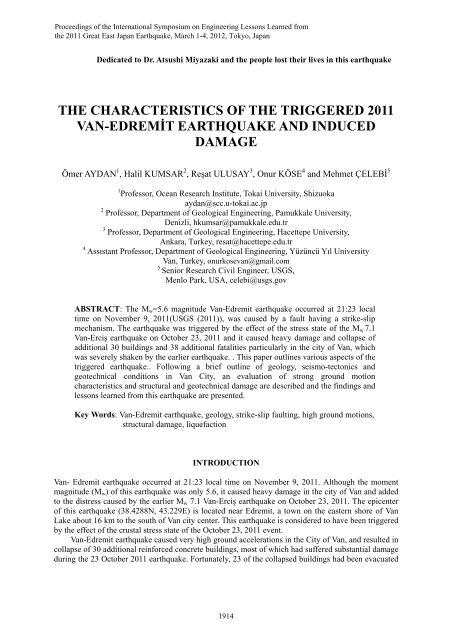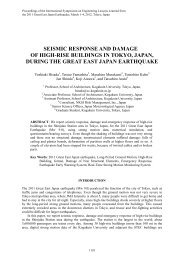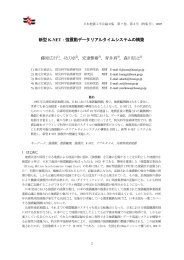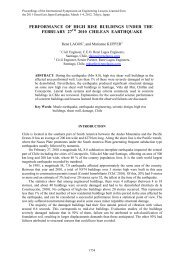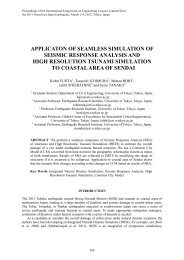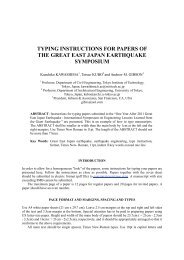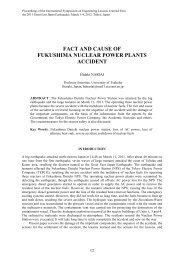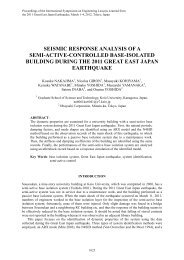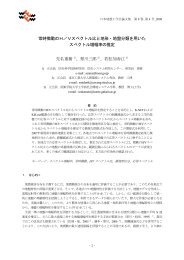The Characteristics of the Triggered 2011 Van-Edremit Earthquake ...
The Characteristics of the Triggered 2011 Van-Edremit Earthquake ...
The Characteristics of the Triggered 2011 Van-Edremit Earthquake ...
Create successful ePaper yourself
Turn your PDF publications into a flip-book with our unique Google optimized e-Paper software.
Proceedings <strong>of</strong> <strong>the</strong> International Symposium on Engineering Lessons Learned from<strong>the</strong> <strong>2011</strong> Great East Japan <strong>Earthquake</strong>, March 1-4, 2012, Tokyo, JapanDedicated to Dr. Atsushi Miyazaki and <strong>the</strong> people lost <strong>the</strong>ir lives in this earthquakeTHE CHARACTERISTICS OF THE TRIGGERED <strong>2011</strong>VAN-EDREMİT EARTHQUAKE AND INDUCEDDAMAGEÖmer AYDAN 1 , Halil KUMSAR 2 , Reşat ULUSAY 3 , Onur KÖSE 4 and Mehmet ÇELEBİ 51 Pr<strong>of</strong>essor, Ocean Research Institute, Tokai University, Shizuokaaydan@scc.u-tokai.ac.jp2 Pr<strong>of</strong>essor, Department <strong>of</strong> Geological Engineering, Pamukkale University,Denizli, hkumsar@pamukkale.edu.tr3 Pr<strong>of</strong>essor, Department <strong>of</strong> Geological Engineering, Hacettepe University,Ankara, Turkey, resat@hacettepe.edu.tr4 Assıstant Pr<strong>of</strong>essor, Department <strong>of</strong> Geological Engineering, Yüzüncü Yıl University<strong>Van</strong>, Turkey, onurkosevan@gmail.com5Senior Research Civil Engineer, USGS,Menlo Park, USA, celebi@usgs.govABSTRACT: <strong>The</strong> M w =5.6 magnitude <strong>Van</strong>-<strong>Edremit</strong> earthquake occurred at 21:23 localtime on November 9, <strong>2011</strong>(USGS (<strong>2011</strong>)), was caused by a fault having a strike-slipmechanism. <strong>The</strong> earthquake was triggered by <strong>the</strong> effect <strong>of</strong> <strong>the</strong> stress state <strong>of</strong> <strong>the</strong> M w 7.1<strong>Van</strong>-Erciş earthquake on October 23, <strong>2011</strong> and it caused heavy damage and collapse <strong>of</strong>additional 30 buildings and 38 additional fatalities particularly in <strong>the</strong> city <strong>of</strong> <strong>Van</strong>, whichwas severely shaken by <strong>the</strong> earlier earthquake. . This paper outlines various aspects <strong>of</strong> <strong>the</strong>triggered earthquake.. Following a brief outline <strong>of</strong> geology, seismo-tectonics andgeotechnical conditions in <strong>Van</strong> City, an evaluation <strong>of</strong> strong ground motioncharacteristics and structural and geotechnical damage are described and <strong>the</strong> findings andlessons learned from this earthquake are presented.Key Words: <strong>Van</strong>-<strong>Edremit</strong> earthquake, geology, strike-slip faulting, high ground motions,structural damage, liquefactionINTRODUCTION<strong>Van</strong>- <strong>Edremit</strong> earthquake occurred at 21:23 local time on November 9, <strong>2011</strong>. Although <strong>the</strong> momentmagnitude (M w ) <strong>of</strong> this earthquake was only 5.6, it caused heavy damage in <strong>the</strong> city <strong>of</strong> <strong>Van</strong> and addedto <strong>the</strong> distress caused by <strong>the</strong> earlier M w 7.1 <strong>Van</strong>-Erciş earthquake on October 23, <strong>2011</strong>. <strong>The</strong> epicenter<strong>of</strong> this earthquake (38.4288N, 43.229E) is located near <strong>Edremit</strong>, a town on <strong>the</strong> eastern shore <strong>of</strong> <strong>Van</strong>Lake about 16 km to <strong>the</strong> south <strong>of</strong> <strong>Van</strong> city center. This earthquake is considered to have been triggeredby <strong>the</strong> effect <strong>of</strong> <strong>the</strong> crustal stress state <strong>of</strong> <strong>the</strong> October 23, <strong>2011</strong> event.<strong>Van</strong>-<strong>Edremit</strong> earthquake caused very high ground accelerations in <strong>the</strong> City <strong>of</strong> <strong>Van</strong>, and resulted incollapse <strong>of</strong> 30 additional reinforced concrete buildings, most <strong>of</strong> which had suffered substantial damageduring <strong>the</strong> 23 October <strong>2011</strong> earthquake. Fortunately, 23 <strong>of</strong> <strong>the</strong> collapsed buildings had been evacuated1914
due to <strong>the</strong> damage caused by <strong>the</strong> October 23, <strong>2011</strong> earthquake. However, two hotel buildings wereopen during this second earthquake and some <strong>of</strong> <strong>the</strong> people staying <strong>the</strong>re lost <strong>the</strong>ir lives. <strong>The</strong> totalcasualties and injured people caused by this earthquake are 38 and 30, respectively.This earthquake also caused some ground liquefaction along <strong>the</strong> <strong>Van</strong> lakeshore and <strong>the</strong> groundliquefaction again occurred at <strong>the</strong> <strong>Van</strong> port, where <strong>the</strong> ground liquefaction was also observed following<strong>the</strong> 23 October <strong>2011</strong> earthquake.This paper outlines various aspects <strong>of</strong> <strong>the</strong> <strong>Van</strong>-<strong>Edremit</strong> earthquake <strong>of</strong> November 9, <strong>2011</strong>. In <strong>the</strong>first part <strong>of</strong> <strong>the</strong> paper, brief outlines <strong>of</strong> geology, seismo-tectonics and geotechnical conditions in <strong>Van</strong>City and its close vicinity are given. <strong>The</strong> second part involves seismic characteristics <strong>of</strong> <strong>the</strong> earthquakeand evaluation <strong>of</strong> strong ground motion characteristics. <strong>The</strong> third part describes both structural andgeotechnical damages, and <strong>the</strong> effect <strong>of</strong> non-appropriate repair <strong>of</strong> <strong>the</strong> buildings is also discussed. In <strong>the</strong>final part, <strong>the</strong> findings and lessons learned from this earthquake are summarized.GEOLOGY AND GEOTECHNICAL CONDITIONSFig. 1 shows <strong>the</strong> geological conditions <strong>of</strong> <strong>the</strong> City <strong>of</strong> <strong>Van</strong> and its close proximity. <strong>Van</strong> is mainly locatedover a mainly alluvial fan (Qey), and <strong>the</strong> area along <strong>the</strong> lakeshore and in <strong>the</strong> vicinity <strong>of</strong> Karasu Riveris mainly composed <strong>of</strong> recent alluvial deposits (Qa). <strong>The</strong> shear wave velocity <strong>of</strong> alluvial deposits <strong>of</strong>recent alluvial deposits (Qa) is estimated to be ranging between 250-300 m/s while <strong>the</strong> shear wavevelocity <strong>of</strong> alluvial deposits (Qey) is about 350 m/s. <strong>The</strong> town <strong>of</strong> <strong>Edremit</strong>, close to <strong>the</strong> epicenter, islocated over travertine deposits (Qpltr).<strong>The</strong>re are several types <strong>of</strong> faults in <strong>the</strong> epicentral area. Besides main thrust faults trending E-W,<strong>the</strong>re are conjugate strike-slip faults with some normal components. Özkaymak et al. (2004)recognized NW-SE and NE-SW trending strike-slip faults. Alabayır fault is one <strong>of</strong> such faults.Fig. 1 Geology <strong>of</strong> <strong>Van</strong> and its close vicinity and faulting mechanisms for <strong>the</strong> <strong>Van</strong>-<strong>Edremit</strong> earthquakeestimated by different institutes (base map from Özkaymak et al., 2004)1915
FOCAL MECHANISM AND SEISMICITYFig. 1 also shows <strong>the</strong> focal mechanisms obtained by USGS (<strong>2011</strong>), ERD (<strong>2011</strong>), KOERI (<strong>2011</strong>) andHARVARD (<strong>2011</strong>). All focal mechanisms solutions indicated that <strong>the</strong> faulting mechanism <strong>of</strong> thisearthquake was due to strike-slip faulting. Although <strong>the</strong> solutions yield two fault planes, NW-SEtrending fault may be <strong>the</strong> causative fault. In view <strong>of</strong> <strong>the</strong> seismicity since November 09, <strong>2011</strong> shown inFig. 2 and recognized fault traces in <strong>the</strong> field, a sinistral NW-SE tending steeply dipping fault shouldbe <strong>the</strong> causative fault. This fault probably is located to <strong>the</strong> east <strong>of</strong> <strong>Edremit</strong>.Fig. 2 Seismicity <strong>of</strong> epicentral areas <strong>of</strong> Nov. 09, <strong>2011</strong> and Oct. 23, <strong>2011</strong> since Nov. 09, <strong>2011</strong>CHARACTERISTICS OF STRONG MOTIONSDuring this earthquake, strong ground motions were recorded by National Strong Motion Network <strong>of</strong>Turkey operated by <strong>the</strong> <strong>Earthquake</strong> Research Department (ERD) and temporarily installed network byKandilli Observatory and <strong>Earthquake</strong> Research Institute (KOERI) following <strong>the</strong> October 23, <strong>2011</strong><strong>Van</strong>-Erciş earthquake. KOERI also installed strong motion stations on both soil (VNKEA) and rock(VNS). <strong>The</strong> maximum ground acceleration recorded by <strong>the</strong> ERD (VBIM) and KOERI (VNKEA) attwo soil ground sites in <strong>the</strong> City <strong>of</strong> <strong>Van</strong> are 0.27 g and 0.29 g, respectively (Fig. 3). Fig. 4 compares<strong>the</strong> acceleration records and acceleration response spectra <strong>of</strong> motions recorded at soil stations whileFigure 5 compares recorded motions and corresponding spectra at soil (VNKEA) and rock stations1916
(VNS). Although <strong>the</strong> amplitudes <strong>of</strong> waves are slightly different, <strong>the</strong> records are quite similar to eacho<strong>the</strong>r. Fur<strong>the</strong>rmore, <strong>the</strong> accelerations are amplifed for periods <strong>of</strong> 0.1-0.15s and 0.35-0.4s.Fig. 3 Locations <strong>of</strong> strong motion stations (base map from Google earth)Fig. 4 Comparison <strong>of</strong> (a) acceleration records and (b) <strong>the</strong>ir acceleration response spectra <strong>of</strong>VBIM-ERD and VNKEA-KOERI stations in <strong>Van</strong>1917
Fig. 5 Comparison <strong>of</strong> <strong>the</strong> acceleration records and <strong>the</strong>ir acceleration response spectra on soil(VNKEA) and rock (VNS) stations in <strong>Van</strong><strong>The</strong> comparison <strong>of</strong> raw acceleration records and <strong>the</strong>ir acceleration response spectra indicated that<strong>the</strong> amplifications were 2.4 and 3.6 times, respectively. Fur<strong>the</strong>rmore, <strong>the</strong> maximum spectralaccelerations roughly correspond to those <strong>of</strong> periods <strong>of</strong> 0.36-0.4 s, which generally corresponds to <strong>the</strong>natural periods <strong>of</strong> 6-8 story reinforced concrete buildings.Fig. 5 shows <strong>the</strong> attenuation <strong>of</strong> strong motions recorded by <strong>the</strong> ERD and KOERI with <strong>the</strong>empirical relations <strong>of</strong> Aydan (2001), Aydan and Ohta (<strong>2011</strong>a) and Ulusay et al. (2004). <strong>The</strong> maximumground acceleration on soil is well predicted by <strong>the</strong> attenuation relation proposed by Aydan (2001)while <strong>the</strong> relations by Aydan and Ohta (<strong>2011</strong>a) using <strong>the</strong> shear velocity <strong>of</strong> <strong>Van</strong> strong motion stationand Ulusay et al. (2004) underestimated <strong>the</strong> maximum ground accelerations by 30-40% less.One <strong>of</strong> important observations in Fig. 5 is <strong>the</strong> effect <strong>of</strong> <strong>the</strong> fault orientation. While <strong>Edremit</strong>station is on <strong>the</strong> stationary or footwall, <strong>Van</strong> station is on <strong>the</strong> mobile or hanging wall side. <strong>The</strong>maximum ground accelerations are almost same, <strong>the</strong> distances <strong>of</strong> <strong>the</strong> <strong>Edremit</strong> and <strong>Van</strong> strong motionstations to <strong>the</strong> fault are 4 and 12 km, respectively. This fact also illustrates <strong>the</strong> fundamental reason forseemingly scattering <strong>of</strong> observed data when spherical and cylindrical attenuation relations areemployed.Aydan and Ohta (<strong>2011</strong>a) improved <strong>the</strong> attenuation relations <strong>of</strong> Aydan (2007) by considering <strong>the</strong> dipangle and fault length also. <strong>The</strong> attenuation relations <strong>of</strong> Aydan and Ohta (<strong>2011</strong>a) for maximum groundvelocity are compared in Fig. 5. <strong>The</strong> computed maximum ground velocity values at <strong>Edremit</strong>, Muradiyeand Bitlis are well estimated by <strong>the</strong> attenuation relations <strong>of</strong> Aydan and Ohta (<strong>2011</strong>a). However, <strong>the</strong>observed value <strong>of</strong> <strong>Van</strong> strong motion station is somewhat higher than <strong>the</strong> estimations when <strong>the</strong> shearwave velocity (V s30 ) <strong>of</strong> 363 m/s is used. <strong>The</strong>refore, <strong>the</strong> concept <strong>of</strong> using <strong>the</strong> shear wave velocity for top30 m ground as <strong>the</strong> representative value <strong>of</strong> site conditions is very questionable. Similar conclusion isvalid for <strong>the</strong> records taken in Japan.1918
Next <strong>the</strong> deformation responses <strong>of</strong> stations (EDR-ERD and VNS-KOERI) located over rock arecompared as shown in Fig. 6(b). If <strong>the</strong> mobile side <strong>of</strong> <strong>the</strong> N-S trending fault is <strong>the</strong> east block, <strong>the</strong> strikeslip faulting implies that <strong>the</strong>re should be considerable permanent ground displacement at VNS-KOERIstation as compared with that at EDR-ERD station. <strong>The</strong> net permanent displacement <strong>of</strong> <strong>the</strong>VNS-KOERI is about 37 mm northward while that <strong>of</strong> <strong>the</strong> EDR-ERD is almost nill. This conclusionmay also be <strong>of</strong> great value to explain why <strong>the</strong>re was huge damage in <strong>the</strong> City <strong>of</strong> <strong>Van</strong> as compared to<strong>the</strong> light damage in <strong>Edremit</strong>.CASUALTIES AND STRUCTURAL DAMAGEThis earthquake resulted in <strong>the</strong> loss <strong>of</strong> 38 lives as it happened at 21:23 in <strong>the</strong> evening. On <strong>the</strong> o<strong>the</strong>rhand, <strong>the</strong> 23 October <strong>2011</strong> <strong>Van</strong>-Erciş earthquake resulted in <strong>the</strong> loss <strong>of</strong> 604 people and occurred at13:41 on Sunday. Fig. 7 shows <strong>the</strong> relations between local magnitude and casualties. <strong>The</strong> estimationsfor upper (UL), mean (ML) and lower (LL) limits are computed from <strong>the</strong> following function proposedin this article using <strong>the</strong> data from various catalogues for Turkey (i.e. Ergin et al. 1967; Soysal et al.1981; Eyidoğan et al. 1991).N )c= A( M L− B(1)<strong>The</strong> values <strong>of</strong> constants A and c are 2 and 7, while <strong>the</strong> values <strong>of</strong> constant B are 3.5, 4.5 and 5.5 for UL,ML and LL, respectively. <strong>The</strong> main reason for such large ranges may be related to <strong>the</strong> time <strong>of</strong>earthquake, quality <strong>of</strong> buildings and ground conditions.Fig. 7 Relation between local magnitude <strong>of</strong> earthquakes and casualtiesThis earthquake caused <strong>the</strong> collapse <strong>of</strong> <strong>the</strong> 30 reinforced concrete buildings, most <strong>of</strong> which hadalready suffered substantial damage during <strong>the</strong> 23 October <strong>2011</strong> earthquake (Photos 1, 2 and 3).Fortunately, 23 <strong>of</strong> <strong>the</strong> collapsed buildings had been evacuated due to <strong>the</strong> damage caused by <strong>the</strong> earlier1920
earthquake. However, two hotel buildings were open during this second earthquake and some <strong>of</strong> <strong>the</strong>people staying <strong>the</strong>re lost <strong>the</strong>ir lives. This earthquake also caused additional damage to some buildings.<strong>The</strong> collapsed hotels had cracks following <strong>the</strong> October 23, <strong>2011</strong> earthquake and <strong>the</strong>y werecosmetically repaired. <strong>The</strong> authors noticed such non-structural repairs in <strong>the</strong> City <strong>of</strong> <strong>Van</strong> during <strong>the</strong>irreconnaissance for <strong>the</strong> October 23, <strong>2011</strong> earthquake (Photo 4).Photo 1 Views <strong>of</strong> Bayram Otel before and after <strong>the</strong> <strong>Van</strong>-<strong>Edremit</strong> earthquake (Anadolu Ajansı, <strong>2011</strong>)Photo 2 Views <strong>of</strong> a collapsed reinforced concrete building in <strong>Van</strong> (Anadolu Ajansı, <strong>2011</strong>)1921
Photo 3 Views <strong>of</strong> heavily damaged reinforced concrete buildings <strong>of</strong> DSI in <strong>Van</strong>Photo 4. Cosmetic repairs applied to a damaged RC building in <strong>Van</strong> on November 5, <strong>2011</strong> after <strong>the</strong><strong>Van</strong>-Erciş earthquake1922
<strong>The</strong> major causes <strong>of</strong> <strong>the</strong> heavy damage to reinforced concrete buildings were basically similar to <strong>the</strong>previous observations during previous earthquakes in Turkey:(a) Quality <strong>of</strong> construction materials,(b) Lack <strong>of</strong> implementation <strong>of</strong> design codes (bars, stir-ups, proper column-beam connections, tie-beams,good foundation etc.),(c) Existence <strong>of</strong> s<strong>of</strong>t-floor (weak-floor),(d) Pounding,(e) Lack <strong>of</strong> ductility,(f) Poor integrity <strong>of</strong> RC frame with in-fill walls,(g) Quality <strong>of</strong> workmanship.(h) Poor ground conditions.Fur<strong>the</strong>rmore, cosmetic non-structural by re-plastering <strong>of</strong> cracked beams, columns, infill-walls and beamcolumn connections had disastrous effects. Similar problem was observed in buildings damaged by <strong>the</strong>1999 Kocaeli earthquake in Düzce during <strong>the</strong> 1999 Düzce earthquake (Aydan et al., 2000a and 2000b).GEOTECHNICAL DAMAGEThis earthquake also caused some ground liquefaction along <strong>the</strong> <strong>Van</strong> lakeshore (Photo 5) and <strong>the</strong>ground liquefaction again occurred at <strong>the</strong> Port <strong>of</strong> <strong>Van</strong>, where <strong>the</strong> ground liquefaction was alsoobserved following <strong>the</strong> 23 October <strong>2011</strong> earthquake. This is probably <strong>the</strong> smallest magnitudeearthquake to cause liquefaction in Turkey so far. Fig. 7 shows <strong>the</strong> grain size distribution <strong>of</strong> <strong>the</strong> boiledsand, which is within <strong>the</strong> most liquefiable bounds with high percentage <strong>of</strong> fine content.Fig. 8 shows <strong>the</strong> empirical relations proposed between earthquake magnitude (M w ) andhypocentral distance <strong>of</strong> liquefaction location proposed by Aydan et al. (1998) and Aydan (2007) with<strong>the</strong> observation in this earthquake. <strong>The</strong> observation is within <strong>the</strong> proposed empirical limits.Photo 5 Views <strong>of</strong> boiled sand in <strong>Van</strong> port due to <strong>the</strong> M5.6 earthquake1923
Fig. 8 Grain size distribution <strong>of</strong> boiled sand sample obtained from Port <strong>of</strong> <strong>Van</strong> immediately after <strong>the</strong>M5.6 earthquakeFig. 9 Comparison <strong>of</strong> empirical relations with observationCONCLUSIONS<strong>The</strong> following conclusions may be drawn from <strong>the</strong> previous sections:(a) This earthquake is not an aftershock <strong>of</strong> <strong>the</strong> October 23, <strong>2011</strong> <strong>Van</strong>-Erciş earthquake. It hasdifferent faulting mechanism. However, <strong>the</strong>re is no doubt that it was triggered due to <strong>the</strong> variation<strong>of</strong> crustal stresses induced by <strong>the</strong> October 23, <strong>2011</strong> earthquake.(b) Although <strong>the</strong> magnitude <strong>of</strong> this earthquake was small, high ground motions with a strongdirectivity effect were recorded. <strong>The</strong> maximum ground accelerations on soil ground wereamplified up to 3.6 times that on rocky ground.(c) <strong>The</strong> main causes <strong>of</strong> heavy damage or collapse <strong>of</strong> reinforced concrete buildings are similar to thoseobserved in previous earthquakes. This earthquake also showed that <strong>the</strong> cosmetic non-structuralrepairs <strong>of</strong> buildings are disastrous and must be avoided.1924
(d) <strong>Van</strong>-<strong>Edremit</strong> is probably <strong>the</strong> smallest magnitude earthquake to cause liquefaction in Turkey so far.Fur<strong>the</strong>rmore, this earthquake caused ground liquefaction in <strong>the</strong> same location again.ACKNOWLEDGMENTS<strong>The</strong> authors sincerely acknowledge <strong>the</strong> information and pictures provided by Mr. Ayhan Koçbayfrom DSI on damage to <strong>the</strong>ir buildings in <strong>Van</strong>.REFERENCESAnadolu Ajansı (<strong>2011</strong>). “Photo gallery for <strong>Van</strong>-<strong>Edremit</strong> earthquake,” http://www.aa.com.trAydan, Ö. (2001). Comparison <strong>of</strong> suitability <strong>of</strong> submerged tunnel and shield tunnel for subsea passage<strong>of</strong> Bosphorus. Geological Engineering Journal, 25(1), 1-17 (in Turkish).Aydan, Ö. (2007). Inference <strong>of</strong> seismic characteristics <strong>of</strong> possible earthquakes and liquefaction andlandslide risks from active faults (in Turkish). <strong>The</strong> 6th National Conference on <strong>Earthquake</strong>Engineering <strong>of</strong> Turkey, Istanbul, Vol.1, 563-574.Aydan, Ö., and Y. Ohta (<strong>2011</strong>a). A new proposal for strong ground motion estimations with <strong>the</strong>consideration <strong>of</strong> earthquake fault. Seventh National Conference on <strong>Earthquake</strong> Engineering,Istanbul, Turkey, paper no: 65(on CD).Aydan, Ö. and Ohta, Y. (<strong>2011</strong>b). <strong>The</strong> erratic pattern screening (EPS) method for estimation <strong>of</strong>co-seismic deformation <strong>of</strong> ground from acceleration records and its applications. SeventhNational Conference on <strong>Earthquake</strong> Engineering, 30May- 3 June <strong>2011</strong>, Istanbul, Turkey PaperNo:66, 10 pages.ERD, <strong>2011</strong>. http://www.deprem.gov.tr.Ergin, K., Güçlü, U. ve Uz, Z. (1967). Türkiye ve Civarının Deprem Kataloğu (MS. 11-1964).İstanbul: İstanbul Teknik Üniversitesi Maden Fakültesi Arz Fiziği Enstitüsü yayınları, No 28.Eyidoğan, H., U. Güçlü and Z. Utku, E. Değirmenci (1991): Türkiye büyük depremleri makro-sismikrehberi, İTÜ.HARVARD (<strong>2011</strong>): http://www.seismology.harvard.edu/KOERI (<strong>2011</strong>). http://www.koeri.boun.edu.tr .Ohta, Y., Aydan, Ö. (2007). An integration technique for ground displacement from accelerationrecords and its application to actual earthquake records (in Japanese). Journal <strong>of</strong> <strong>The</strong> School <strong>of</strong>Marine Science and Technology, Tokai University, Vol.5, No.2, pp.1-12.Özkaymak, Ç., Yürür, T., and Köse, O. (2004). : An example <strong>of</strong> intercontinental active collisionaltectonics in <strong>the</strong> Eastern Mediterranean region (<strong>Van</strong>, Eastern Turkey). <strong>The</strong> Fifth Int. Symp. onEastern Mediterranean Geology, <strong>The</strong>ssaloniki, T1-44, 4 pages.Soysal, H., Sipahioğlu, S., Kolçak, D. & Altınok, Y. (1981). Türkiye ve Çevresinin Tarihsel DepremKataloğu (2100 B.C.–1900 A.D.). TÜBİTAK raporu, No. TBAG-341.Ulusay, R., Tuncay, E., H. Sonmez, H., and Gokceoglu, C. (2004). An attenuation relationship basedon Turkish strong motion data and iso-acceleration map <strong>of</strong> Turkey. Engineering Geology, 74,265-291.USGS (<strong>2011</strong>): http://earthquake.usgs.gov/earthquakes/.1925


